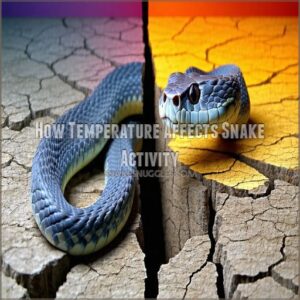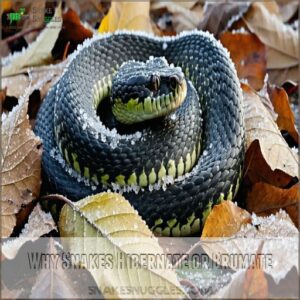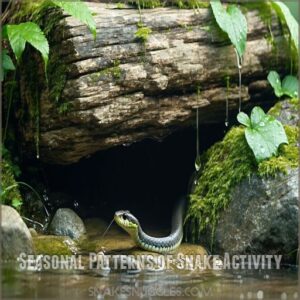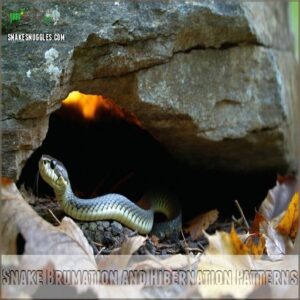This site is supported by our readers. We may earn a commission, at no cost to you, if you purchase through links.

They’re like Goldilocks: too cold below 60°F, and they’re sluggish; too hot above 90°F, and they risk overheating.
Early spring sightings may happen at cooler temperatures (50-60°F), especially with species like rattlesnakes emerging from hibernation.
Since snakes don’t produce their own heat, basking in the sun is their version of warming up for the day. They’re most active when it’s comfortable for you to enjoy a hike—provided you avoid surprise encounters. Understanding their habits might just help you stay safe out there!
Table Of Contents
- Key Takeaways
- What Temperature Do Snakes Come Out
- Optimal Temperature for Snake Emergence
- How Temperature Affects Snake Activity
- Where Do Snakes Hibernate
- Why Snakes Hibernate or Brumate
- Seasonal Patterns of Snake Activity
- Geographic Variations in Snake Emergence
- Snake Brumation and Hibernation Patterns
- Safety Precautions in Snake-Active Areas
- Factors Influencing Snake Sightings
- Frequently Asked Questions (FAQs)
- At what temperature do snakes not come out?
- Are snakes out in 50 degree weather?
- What is the best time of day to avoid snakes?
- How cold is too cold for a snake?
- What temperature are snakes most active at?
- What is the best weather to find snakes?
- Do all snake species emerge at the same temperature?
- How quickly do snakes react to temperature changes?
- Can snakes survive brief exposure to extreme temperatures?
- Do baby snakes emerge at different temperatures than adults?
- Conclusion
Key Takeaways
- Snakes are most active when temperatures hit 68-80°F, their ideal range for movement, hunting, and basking.
- They retreat or become sluggish below 60°F, and above 90°F they risk overheating and seek shelter.
- Spring triggers the first activity for many snakes, with some, like rattlesnakes, emerging at cooler 50-60°F.
- Regional factors like altitude, habitat, and climate heavily influence when snakes come out and how active they are.
What Temperature Do Snakes Come Out
Ever wonder what temperature snakes come out? It’s not a single magic number; snake emergence triggers vary wildly!
Daily temperature impact is key: above 68-80°F (20-27°C) often gets them moving. Think of it like this: snakes are cold-blooded, so warmth is their wake-up call.
For example, rattlesnakes typically start emerging in the spring when temperatures reach 50-60°F (10-15°C). Weather effects, like a sudden heatwave, can also rouse them.
Elevation influence is real, too; higher altitudes mean later emergence. Regional variations are huge; a desert snake’s activity temperature differs drastically from a mountain snake’s.
So, what temperatures snakes are active depends on many things – it’s a bit of a snake-y puzzle! When do snakes become active? Mostly in spring and summer, but warmer days in other seasons can do the trick.
Optimal Temperature for Snake Emergence
Snakes usually get moving when temperatures hit the sweet spot of 68-80°F (20-27°C), which is their goldilocks zone for activity.
Maintaining this optimal temperature range is essential for their health and well-being.
It’s like the perfect snooze button for snakes emerging from hibernation.
Different species have unique preferences, though—some desert snakes might handle higher temperatures, while forest dwellers prefer cooler conditions.
Microclimates and elevation effects also play a role, creating slight geographic differences.
These cold-blooded creatures count on external heat to power their energy, so spring’s warming weather often triggers the first movements.
If you’re wondering when snakes become active, keep an eye on the thermometer as your guide!
How Temperature Affects Snake Activity
You’ve probably noticed how snakes seem to “wake up” when the weather’s just right—temperature plays a huge role in their activity.
When it’s too cold, they’re sluggish; when it’s too hot, they’re hiding, making that perfect middle range their sweet spot for moving, hunting, and basking.
Temperature Influence on Movement
Temperature and snake movement go hand in hand.
Understanding why your snake is suddenly more active, especially considering environmental factors, can be essential for their well-being; check out this guide on increased snake activity for more details.
Below 60°F, their speed dips drastically, making them sluggish and less active—like trying to run through peanut butter.
Warmer days (70-90°F) bring their energy back, sparking swift movements and basking behaviors.
Hit 95°F or higher, though, and heat stress slows them down again.
Nature’s thermostat controls snake activity levels perfectly.
Impact on Metabolism and Behavior
As snakes heat up, their metabolic rate shifts into gear, kind of like a car engine warming on a cold morning. This thermoregulation impact fuels behavioral changes like hunting or basking.
Below 60°F, though, they’ll conserve energy.
Watch for these temperature-driven behaviors:
- Increased activity levels at warmer temperatures.
- Slower movement and digestion effects when cooler.
- Temperatures directly steering snake activity patterns.
Ideal Temperature Range for Activity
Think of snakes like solar-powered creatures—they’re most active when temperatures hit their sweet spot: 70–90°F.
Below 60°F, they’re sluggish; above 95°F, it’s like a heatwave meltdown.
This range fuels their basking behavior, sharpens movement, and keeps metabolism humming. These thermoregulation strategies help balance cold tolerance and heat stress, ensuring their emergence aligns perfectly with ideal snake temperatures and behavior.
Where Do Snakes Hibernate
You might be surprised to learn that snakes have some pretty clever hiding spots for surviving the winter.
From cozy dens in rock piles to snug burrows or even tucked-away corners of your basement, snakes know how to make the most of nature—and sometimes your home!
Types of Hibernacula
Snakes aren’t picky about their winter lodgings! Hibernacula locations vary wildly.
Some snakes use pre-existing burrows, while others, like Northern Pine Snakes, are DIY experts in den construction.
Hibernacula size depends on the species and the number of snakes sharing the space. Communal dens are common, providing warmth and safety in numbers.
The ideal snake hibernation temperature for a cozy winter’s nap is around 40-50°F.
When snakes emerge in spring depends on the temperature climbing above 68-80°F.
Shared Hibernacula and Communal Dens
In many cases, snakes share hibernacula to conserve energy and gain group benefits like retained heat. Yet, it’s not all cozy—expect competition for space and higher disease risks.
Communal dens may host thousands, especially in colder regions. These gatherings maximize survival when snake hibernation temperatures drop.
Shared spaces play a key role in snake emergence temperature patterns.
- Energy conservation boosts survival odds.
- Communal dens host multiple snake species.
- Higher density raises competition for space.
- Group warmth helps in extreme cold.
- Disease spreads faster in shared environments.
Hibernation in Houses and Basements
When shelters like caves aren’t available, snakes hibernate in basements, attics, or foundations.
Your warm home offers a cozy refuge during brumation at lower temperatures. Gaps in walls or under doors become entry points.
Preventing home hibernation starts with sealing cracks and proper insulation.
Winter snake entry can surprise you, but removal methods, like humane traps, guarantee safety.
Why Snakes Hibernate or Brumate
Snakes hibernate or brumate to conserve energy and survive the cold when their bodies can’t regulate heat like ours do.
Think of it as their way of hitting “pause” during winter.
since chilly weather makes basking and hunting nearly impossible.
Energy Conservation and Survival
Think of hibernation and brumation as a snake’s survival hack when temperatures drop. Their metabolic slowdown reduces energy needs, allowing them to survive months without eating.
The benefits of brumation extend to water absorption too—snakes hydrate through their skin even in deep "sleep."
Hibernation sites, like burrows or basement crevices, shield them from extreme cold. Survival rates depend on proper preparation; a poorly fed snake faces risks.
It’s temperature effects on snakes’ movement that signal when they’ll rest—or reappear when conditions improve.
Cold-Blooded Nature and Temperature Regulation
Snakes’ survival hinges on their cold-blooded nature, which means their body temperature mirrors the environment.
Without the luxury of internal heaters like us, they rely on clever thermoregulation strategies. Basking behavior helps them soak up warmth, while shade cools them down when it’s too hot.
The preferred temperatures for peak snake activity hover between 70°F and 90°F. Below 60°F, they’re sluggish, above 95°F, it’s potentially dangerous.
These body temperature fluctuations explain why you’ll spot snakes heat-seeking on sunny rocks or avoiding extremes during harsher weather. Temperature drives their every move.
Seasonal Patterns of Snake Activity
You’ve probably noticed how snakes seem to follow their own schedule, appearing more in some seasons and disappearing entirely in others.
Their activity is tied to temperature, with spring bringing them out for warmth and mating, summer keeping them busy hunting, and fall marking their slow retreat as winter settles in.
Peak Activity Periods
In North America, snake activity peaks from April to October.
These are the best times for sightings, driven by daily cycles and temperature, particularly in diverse ecosystems like snake habitat in the grasslands.
Snake activity temperature preferences mean warmer days bring more action.
Regional variations exist; "when are snakes most active?" depends on your location.
Understanding seasonal patterns and snake activity by temperature helps you stay safe.
Knowing when do rattlesnakes come out, for instance, requires local knowledge.
Spring Emergence and Mating
When the days warm to around 68-80°F, snakes emerge from hibernation, kicking off the snake breeding season.
Spring emergence triggers courtship displays and mating rituals, with males often competing for mates.
Early warm weather snakes, like garter snakes, may be first to appear, searching for mates and ideal nest site selection to guarantee reproductive success.
Summer and Fall Activity
During summer, snakes embrace dawn and dusk, dodging extreme midday heat. They thrive in prey abundance, basking briefly before hunting.
Wondering, "Do snakes like 90-degree weather?" Not really—they avoid overheating.
Autumn signals a Fall retreat, with colder nights wrapping up seasonal shedding.
Snakes’ active hours and temperature drop as they prepare for brumation, moving less and eating sparingly.
Geographic Variations in Snake Emergence
When snakes emerge depends a lot on where you live—think of it like nature setting different alarm clocks across the map.
In colder areas, snakes sleep in longer, while in warmer regions, they’re up and moving earlier, often before you’ve had your morning coffee.
Latitude and Climate Impact
Latitude and climate work together like an intricate dance, shaping when snakes come out in spring. Higher latitudes, with slow-to-warm temperatures, delay snake active hours, while lower ones extend their season. At elevation? Shorter summers mean snakes emerge from hibernation later.
- Regional variations: Warmer states see snakes earlier.
- Elevations’ role: Cooler mountain zones limit activity.
- Climate change influence: Shifting patterns adjust snakes’ timing.
- Temperature effects on movement: Snakes love steady warmth.
When are snakes most active? It depends—location is everything.
Habitat and Microclimate Effects
Where snakes choose to hibernate and emerge depends a lot on the nitty-gritty of their habitat.
Microclimate variations, like humidity’s role or vegetation cover, tweak how and when snakes come out in spring. A sunny rock pile might warm up early, pulling snakes from hibernation sooner, while a shady burrow delays them.
As seen in the diverse global distribution of snakes in various snake habitat map, their adaptations to local environments play a significant role in their activity patterns.
Prey availability and shelter impact behavior too—snakes won’t budge if food’s scarce or cover’s lacking.
Temperature effects on snakes’ movement and activity are nuanced, dancing around snake-active hours and local quirks.
Snake Brumation and Hibernation Patterns
You’ve probably wondered how snakes handle winter’s chill without a cozy blanket.
During brumation or hibernation, they slow everything down—heartbeats, metabolism, even their social lives—to survive freezing temperatures until it’s warm enough to emerge.
Brumation Vs Hibernation
So, we’ve looked at how geography affects when snakes wake up. Now, let’s talk about brumation versus hibernation.
It’s like this: hibernation’s for cold-climate snakes, brumation’s for warmer areas. Both slow metabolism and heart rate, but brumation’s a lighter sleep. Think of it as a long nap versus a deep winter slumber.
Species variations exist; some snakes brumate deeply, others less so. Metabolic rates plummet in both, but survival rates are affected by how well they prepared beforehand.
Knowing this helps you understand what temperature do snakes come out, especially when dealing with pet snakes. Hibernation triggers are usually temperature drops, while brumation is more about a combination of temperature and food availability. Snakes emerging from hibernation or brumation are more common in spring.
Duration and Timing of Brumation
The duration of brumation varies greatly, influenced by species, geographic location, and brumation triggers like temperature shifts.
Snake owners can also prepare for their pet’s emergence by checking the best snake waking temperature at snake warming products.
In colder regions, snakes hunker down from late fall to early spring, sometimes up to six months, while warmer climates may see shorter periods.
Climate change impacts these patterns, altering when snakes come out of hibernation.
Brumation length depends on the temperature snakes become inactive, usually below 60°F.
Expect snakes emerging from hibernation as spring temperatures climb to 68-80°F, signaling safety to venture out.
Safety Precautions in Snake-Active Areas
When you’re in snake-active areas, it’s smart to stay prepared and alert because a little caution can go a long way.
Whether it’s sturdy boots, long pants, or sticking to clear trails, simple steps can help you avoid an unexpected encounter with these slippery neighbors. simple steps and avoid an unexpected encounter.
Protective Gear and Clothing
Snakes may be fascinating, but during active seasons, your outdoor wardrobe could save you major hassle. When snake activity surges, it’s smart to gear up right.
Knowing snake habitats and behavior can inform your protective gear choices, like opting for sturdy, thick clothing to counter their camouflage skills.
Here’s what helps:
- Snake-proof boots: These keep fangs far from your toes. High-ankle footwear works wonders for extra security.
- Sturdy, thick clothing: Long pants add a strong barrier against bites.
- Protective layers: Denim or canvas is tough but comfortable for outdoor safety.
- Avoid thin fabrics: They won’t hold up against strikes.
- Gloves: Handy for handling debris in snake-prone areas.
Trail Safety and Encounter Protocols
When hiking during snake-active hours, stick to clear trails and avoid stepping into dense brush or tall grass.
If you spot a snake, maintain a safe distance—about the length of a car is a good rule of thumb. Snakes, at ideal temperatures (70-90°F), often display defensive postures but won’t chase you. Stay calm, back away slowly, and observe its behavior.
Carry a snake bite first aid kit and know local emergency contacts.
Temperature effects on snakes’ movement mean they’re more active when it’s warm, less so when it’s cool.
Factors Influencing Snake Sightings
You’ll spot snakes more often when the weather plays nice—warm temperatures, a touch of humidity, and the right amount of rain can coax them out of hiding.
Add in human activity disturbing their habitats, and snakes might just cross your path more than you’d like!
Temperature and Humidity Effects
Humidity plays a surprising role in snake behavior. High moisture levels can boost activity, keeping snakes hydrated while aiding prey availability.
Ideal temperature thresholds (70-90°F) align with peak movement, but too much heat causes stress, forcing snakes to seek shade.
Here’s how you’ll spot them:
- Warm, humid mornings: Active hunting.
- Dry heat: Limited movement.
- After rain: Increased sightings near puddles.
Precipitation and Weather Patterns
High humidity makes snakes more visible, but what about rain?
Rainfall effects on snake activity depend on the intensity, and for those interested in products related to this phenomenon, snake rain activity gear can be quite useful.
Light showers mightn’t bother them, but heavy downpours or flooding influence their behavior, forcing them to seek higher ground. Think of them as tiny, scaly swimmers avoiding a sudden flood!
Drought effects are the opposite; snakes become less active during dry spells.
Climate change effects are unpredictable, altering snake weather patterns and making it harder to predict when are snakes most active.
Do thunderstorms affect snakes behavior? Probably, but more research is needed.
Human Activity and Habitat Disruption
Human activity shakes up snake behavior, especially with urban sprawl and deforestation. Snakes adapt, and sightings often spike near construction zones or in gardens. What’s behind this? Habitat loss shifts their homes closer to yours.
- Avoid dense vegetation around homes.
- Seal foundations to block entry.
- Don’t leave clutter like woodpiles.
- Use conservation efforts to protect natural habitats.
- Learn snake behavior for safer coexistence.
Frequently Asked Questions (FAQs)
At what temperature do snakes not come out?
Snakes typically stay hidden when temperatures dip below 60°F.
They become sluggish and can’t function well in the cold.
So they retreat to warm, sheltered spots or hibernation dens to conserve energy and survive.
Are snakes out in 50 degree weather?
At 50°F, snakes usually stay hidden since it’s too cold for their bodies to function well.
Still, a brief appearance isn’t impossible if they’re desperate to warm up or explore a sunny patch.
What is the best time of day to avoid snakes?
Picture a hidden rhythm of nature—snakes move when it’s warm.
To avoid them, explore early mornings or evenings when temperatures are cooler.
They shy away from the chill, giving you safer moments outdoors.
How cold is too cold for a snake?
Temperatures below 60°F (5°C) make snakes sluggish.
They become inactive and seek shelter, as colder temperatures slow their metabolism.
Think of it like you needing a warm blanket on a chilly night!
What temperature are snakes most active at?
Think of snakes like sunbathers chasing the perfect tan.
They’re most active when it’s 70-90°F.
That range keeps them warm enough to move, hunt, and mate, but not so hot they overheat.
What is the best weather to find snakes?
Snakes love warm, sunny days around 70–90°F, especially after a cool night.
You’ll spot them basking on rocks or trails.
Add a little humidity or recent rainfall, and you’ve got prime snake-watching conditions.
Do all snake species emerge at the same temperature?
Not all snake species slither into action at the same temperature.
Many emerge around 68–80°F, but their preferences vary.
Northern snakes often need warmer days, while southern species can stir at slightly cooler ranges.
How quickly do snakes react to temperature changes?
They’re surprisingly quick—snakes respond to temperature changes within hours or even minutes.
When it warms up, they’ll slither out to bask, but a sudden cold drop sends them scurrying back to shelter.
Can snakes survive brief exposure to extreme temperatures?
A snake can handle brief exposure to extreme temperatures, but prolonged exposure can be fatal.
It’s like you stepping outside without a coat in a blizzard—short bursts are manageable, sustained exposure isn’t.
Do baby snakes emerge at different temperatures than adults?
Adult and baby snakes generally emerge at similar temperatures; around 68-80°F (20-27°C) triggers their activity. However, smaller snakes might need slightly warmer conditions.
Conclusion
Think of snakes as nature’s thermometers—they come out when the world feels just right.
Between 68-80°F, they’re most active, using the sun to heat up their cold-blooded bodies.
But they’ll surprise you in cooler spring temps or retreat when summer sizzles past 90°F.
Understanding what temperature snakes come out helps you stay prepared, whether hiking or gardening. Keep an eye on their patterns, respect their space, and you’ll avoid turning curiosity into a close encounter!


















